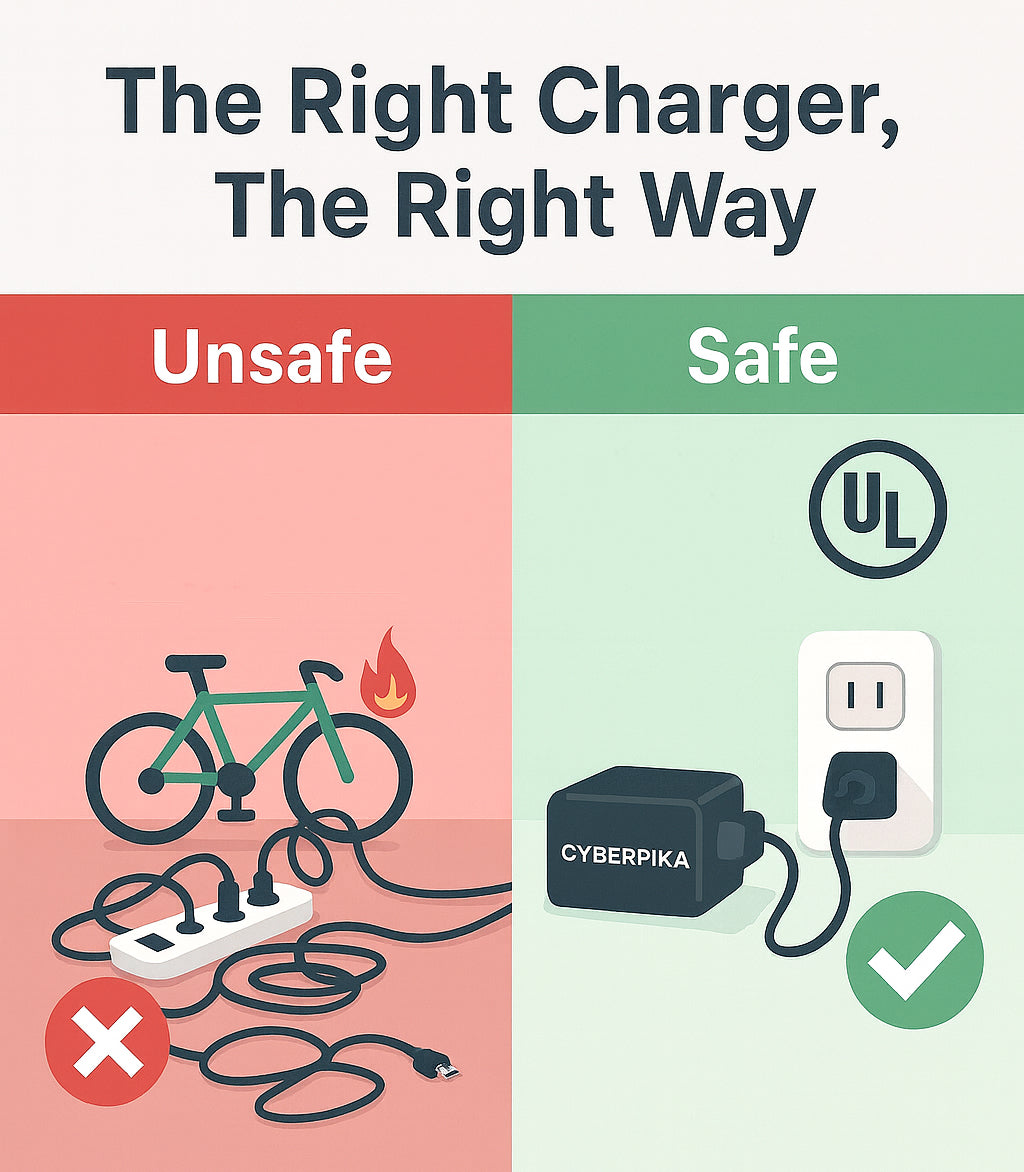In the world of e-bikes, your charger is more than just a power cord—it's a critical safety device. Using the right one, in the right way, is the single most important action you can take to protect your investment and, most importantly, your home. While e-bike battery fires are rare, they are almost always preventable and can often be traced back to one common culprit: the charger.
Think of it this way: your charger is the gatekeeper that safely transfers electricity from your wall to your battery. If that gatekeeper is unqualified or damaged, it can create a dangerous situation. This guide will help you understand what makes a charger "the right one," from safety certifications to the simple habit of where you plug it in.
Part 1: Certifications & The "Right" Charger
Your charger should not be a generic, off-the-shelf component. It should be a purpose-built safety device. Here’s what you need to know about a charger’s credentials.
The Gold Standard: UL 2849 & UL 2271
When shopping for an e-bike, look for a brand that proudly displays its UL certification. In North America, this is the gold standard for safety.
- UL 2849: This certification is a comprehensive safety standard that tests the entire electrical system of the e-bike, including the battery, motor, controller, and, most importantly, the charger. It verifies that all components work together safely to prevent fire and electrical shock hazards.
- UL 2271: This standard focuses specifically on the battery pack itself. It evaluates the battery's safety from a variety of risks, including overcharging, short-circuiting, and extreme temperatures.
A charger that is part of a UL 2849-certified e-bike has been rigorously tested and approved to work seamlessly and safely with its corresponding battery. If you ever need to replace your charger, always buy a certified, manufacturer-approved replacement from a reputable source. Never buy a generic or unbranded charger, even if the plug looks the same. An incompatible charger with the wrong voltage or amperage can cause serious damage and fire.
Part 2: The Right Way: Cables, Plugs, and Habits
Even the best charger can become a safety risk if used improperly. The simple act of where and how you plug it in can make all the difference.
The Plug: Avoid Extension Cords and Power Strips
This is a critical rule that is often overlooked. It's tempting to use a long extension cord to reach your bike in the garage or a power strip to charge multiple devices at once. Don’t do it.
- The Risk: Most extension cords and power strips are not rated for the sustained, high power draw of an e-bike charger. Using one can cause the cord to overheat, leading to a fire. Furthermore, cheap power strips can be a source of electrical arcing or short circuits.
- The Safe Habit: Always plug your e-bike charger directly into a wall outlet. This ensures that the power is delivered safely and efficiently. If you need to charge in a specific location, consider having an electrician install a dedicated outlet instead of relying on an extension cord.
The Cable: Inspect for Damage
Your charger's cable and connectors are not indestructible. They are subject to wear and tear from being coiled, uncoiled, and stepped on.
- The Risk: Frayed wires, loose connections, or a damaged plug can create a fire hazard. A worn-out cable can lead to a short circuit or an unstable charging process.
- The Safe Habit: Before every charge, take a moment to inspect the entire length of the cable and the plug itself. Look for any signs of fraying, cuts, discoloration, or a loose fit. If you notice any damage, stop using the charger immediately and replace it with a certified, manufacturer-approved replacement.
The Final Rule: Charge with Care
Even a perfect charger and outlet setup can’t replace common sense.
- Be Present: Never charge your e-bike battery unattended, and especially never overnight. While modern chargers have overcharge protection, it's always safest to monitor the process and unplug the battery once it’s full.
- Know the Red Flags: If your charger or battery ever feels excessively hot, makes unusual sounds (hissing, popping), or emits a strange odor, unplug it immediately.
Conclusion: A Smart Habit for a Safe Ride
Choosing and using the right charger for your e-bike is a small but hugely important part of responsible ownership. By understanding the importance of certifications, plugging directly into a wall outlet, and routinely inspecting your equipment, you are taking proactive steps to protect your e-bike and your home. So, ride with confidence, knowing that you’re charging your way to a safer, smarter ride.


Share:
Temperature Matters: Charge Your Battery in the Goldilocks Zone (10–30°C)
After the Ride: Cool-Down Rules Before You Plug In